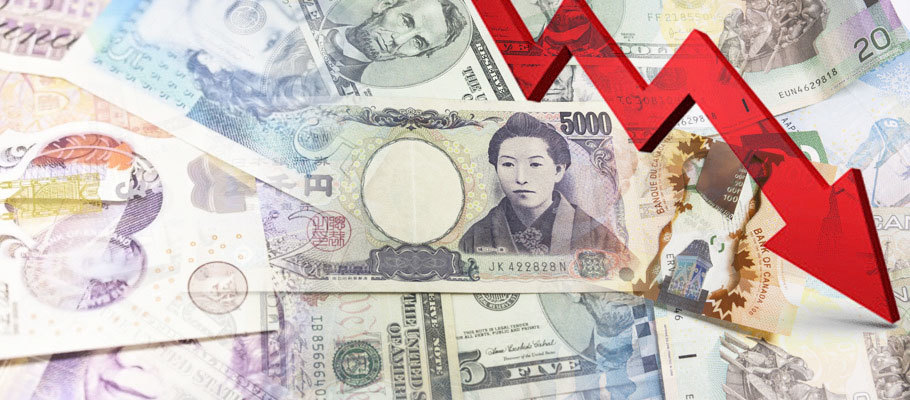
Published: March 23rd, 2020
The past few weeks have been rough for economies all over the world. Many central banks have cut base lending rates to historical lows to help the various countries contain the harsh effects of the coronavirus pandemic. These cuts, however, have not helped much. Instead, most governments have had to augment their actions with massive sell-off of stocks and injections of billions of dollars into their various economies. As a result, stocks have been destabilized and various currencies have taken a hit.
Despite the imminent slide into depression, the demand for the global reserve currency was at an all-time high last week spiking the value of the greenback. The dollar gauge rose to record highs following a rush for hard cash as governments acted in anticipation for an extended coronavirus pandemic.
Each of the Group-of-Ten currencies tanked. However, it is the Norwegian Krone that suffered the most, probably because of its heavy link to oil. The traditionally safe JPY also lost 1.4%. The poor performance by these currencies is attributed to the evaporating liquidity occasioned by investors’ shift from equity to safer positions that are likely to meet margin calls.
According to a portfolio manager for Nikko Asset Management Limited Chris Rands, everything in the market is up for sale and is moving. He adds that markets are doing the absolute bare minimum. Rands, however, thinks that whoever is offering to sell anything when the market conditions are this precarious is crazy.
The Nikko Asset exec does not think the dollar stampede will go away. Despite the attempt by the Federal Reserve and its peer central banks to forestall a global recession, the dollar seemed to gain unabated. The central banks recently embarked on ambitious undertakings that included improving liquidity by doing swaps, giving emergency rate cuts, and engaging in repurchase operations.
The efforts highlighted above have not helped much because of the stringent actions that most countries have reinforced to deal with the coronavirus outbreak. With the continued spread of the virus and the mounting death toll, most countries such as South Korea, Iran, Italy, and Spain that are hard hit have closed their borders. The measure, though necessary in curbing the spread of coronavirus, has strangled trade and commerce and led to cash flow crunches for local companies.
Both France and Italy saw their sovereign bonds spike following an announcement by the European Central Bank (ECB) to offer huge boosts to the capital markets and local European economies. The efforts, however, have done little to hold the Euro from a freefall. The Fiber shed 1% on Thursday. The union’s international stocks benchmark, the Stoxx 600 also failed to hang on choosing instead to spill all its previous gains.
While the euro was falling, the Bloomberg Dollar Spot Index was on overdrive, raking in 1.1% to record an all-time high. Stephen Innes who heads the Markets Strategy at AxiCorp Limited says that the Spot Index’s impressive performance is due to the disproportional demand for the dollar.
According to Innes, there is a liquidity mismatch where the demand for the U.S. dollar far outweighs the supply. He adds that the policy measures applied by governments and central banks are utterly defenseless against the overwhelming nature of the weakness felt across bond markets, equities, and credit markets.
These sentiments are echoed by Societe Generale SA’s chief currency strategist Kit Juckes. According to him, the central bankers’ Achilles’ heel is their overall lack of liquidity. He adds that this shortage coupled with the limited supply of dollars across all markets is making G-10 currencies assume a trading trend that resembles that of emerging markets’ (EM) currencies. The phenomenon, Kit said, is supporting the dollar regardless of any underlying fundamentals.
The sell-off that has led to the plunge of G-10 currencies is prompting a discussion about the need for coordinated intervention, especially, in the forex markets. The last time such an action was necessary was back in 2011 in the wake of the Japanese earthquake.
Chris Turner who is the head of foreign exchange strategy at ING Bank and the bank’s global head of markets predicted that talk about an intervention may be unavoidable. In a note he sent out to the bank’s clients, Turner said that the biggest fan of currency interposing the White House.
Already, policymakers are leaning towards interventions independently. The Federal Reserve which early last week further slashed its base rates has promised to increase its spending in bond buybacks. This measure is in addition to the attempts at providing increased dollar liquidity to calm the bond markets. Besides, the American central bank is exploring additional efforts that will broaden whatever interventions it may take.
The Bank of Japan, on the other hand, promised on Thursday to avail 1 trillion yen (Approx. $9.2 billion) to buy bonds in what market experts think is an unscheduled operation. The Reserve Bank of Australia has also promised to buy bonds across the economy’s yield curve in a bid to rectify the market dislocations.
Elsewhere in Switzerland, the Swiss National Bank is ramping up its currency interventions to shield the franc and protect the currency’s haven status and stem any negative advances. The Swiss franc has gained about 3% against the euro this year alone.
An economist at Seoul’s Shinhan Bank Min Gyeong-won notes that central banks seem to be easing their positions. This change in approach, he says, means more dollars are stacked as a result.
The events in the money markets characterized by increased sell-offs have caused the U.S. dollar to spike. Increased demand for the dollar has now surpassed the supply. And, as governments continue to implement desperate measures to tame the tide of the coronavirus pandemic, the position of the dollar gets even more stable. Central banks seem disinterested in this new status of the dollar then they are with finding practical solutions for their bruised economies.